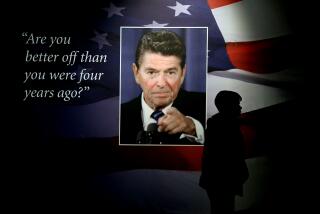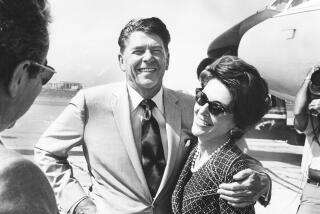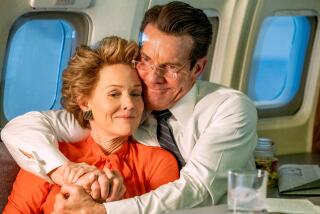NEWS ANALYSIS : Reagan’s Reality : Museum Offers a View of Life and the Presidency Carefully Scripted From One Man’s Viewpoint
- Share via
SIMI VALLEY — The voice is familiar, and so is the message:
“All of us have a place to go back to. Dixon is that place for me.”
The speaker, on tape, is Ronald Reagan. The setting is the museum in the Ronald Reagan Presidential Library. The visitor is surrounded by Reagan boyhood memorabilia: his maroon Eureka College varsity football letter sweater; a mock-up of a living room that evokes his wood-frame home on Hennepin Avenue; faded, black-and-white school pictures.
But there’s one problem: Dixon, Ill., may consider itself Reagan’s hometown, and so may Reagan, but it’s hardly the place to which he goes back.
And so it is, throughout the museum that presents itself as the story of the Reagan presidency and the formative years of the 40th President of the United States.
Just as the carefully scripted Reagan White House in the 1980s presented the nation with its own view of life in the United States--a few crafted very much from the ideals of small-town America when Reagan was a lad--the reality of the Reagan era, as presented at his library, is reality as seen primarily by one man: Ronald Reagan.
The library’s museum offers visitors the soul of the Reagan era--reflecting, as Reagan himself did, a readiness from time to time to dance lightly over hard facts, to color the world in stark absolutes, to give little ground to others’ assessments and to ignore as much as possible disagreeable intrusions.
It has all the lasting, emotional impact of a catchy campaign song.
Beyond the gift shop selling T-shirts, election-victory front pages, and a thick volume of his speeches; beyond the gallery telling us about life in Tampico, Ill., where he was born, and nearby Dixon, where he went to high school; beyond the movie posters and one, ever-so-small picture of first wife, Jane Wyman, “circa 1946,” with son Michael and daughter Maureen; beyond, in short, the context of his first 70 years--the Reagan presidency itself comes to life in pictures, artifacts, headlines, handwritten letters and, appropriately, videos of Reagan telling us jokes, talking about Hollywood, and discussing democracy and totalitarianism.
“There is a lot of video. That captures the flavor of Ronald Reagan,” said Nancy Green, the exhibit’s designer.
The research library contains the heart of the Reagan presidency. About 55 million pages of documents--minutes of meetings, letters to heads of state, detailed accounts of discussions on, say, the development of a product liability policy--will ultimately be stored in stacks and vaults beneath the galleries and green courtyard, library director Ralph Bledsoe said.
We’re not talking about that. We’re talking about the museum.
Presidential libraries are meant for scholars. The museums affiliated with them are meant for the people. They are monuments to the Presidents after whom they are named. Would one expect to find an objective treatment of the pharaohs on a dig of the pyramids?
The purpose of any modern presidential library, said Bledsoe, is to reflect “the particular view of history that Presidents have, and have had, in this country.”
The former President and his wife “together looked at and chose every artifact, every photograph, that went into the exhibition,” Green said.
Some of it is absolutely fascinating: Four handwritten letters to Soviet leaders, including two to Mikhail S. Gorbachev--one addressing him correctly, by his former title of Communist Party general secretary, and another addressed curiously to “Dear Secretary General Gorbachev.”
Some of it has the curious appeal of a moon rock: a chunk of twisted metal taken from a Soviet SS-20 medium-range nuclear missile destroyed under the Intermediate Nuclear Forces treaty Reagan signed with Gorbachev in the East Room of the White House in 1987.
Some of it is, well, charming: The intentionally schlocky costume Nancy Reagan wore when she sang the song “Second Hand Rose” at the annual show of the Gridiron Club in Washington. Under fire for the purchase of expensive new china for the White House and for her acceptance of gowns donated by top designers, she made a determined effort to repair her image that night. She sang a solo poking fun at her extravagant ways and earned rave reviews for being a good sport.
The galleries are organized chronologically during Reagan’s pre-presidency years: boyhood, Hollywood, the California governorship, and the 1976 and 1980 presidential campaigns. (His half-hearted, last-minute stab at the Republican presidential nomination in 1968, which went nowhere, is ignored.) His presidency, to which 40% to 50% of the museum space is dedicated, is covered thematically: foreign policy, the economy, life in the White House.
“The goal, all the way along, was really to try to present his ideas,” Green said.
The displays covering the years before Reagan entered the White House are intended to place him in the context of his times and to present the development of his political philosophy. This is a common, effective approach in presidential museums.
Ann Bethel, two months into her post as the museum’s first curator, said: “It’s very important for a presidential library and archive not to idealize a President. It’s about his role as President. If we . . . were to try to present an idealized picture of him, the sophisticated public would dismiss us.”
The Reagan museum does not drown the visitor in blatant praise of the former President. Nor does it dwell on his failures. But there is little context to give meaning to the neatly organized accounts of Reagan’s efforts in such areas as the economy and arms control, and little discussion of their full impact--although one person’s “context” could be another’s editorializing, or irrelevance.
The Iran-Contra scandal is there: four newspaper headlines and a roughly 200-word account.
There is a brief account, too, of the 1986 summit in Reykjavik, Iceland. Reagan and Gorbachev nearly agreed then on a plan to do away with their arsenals of nuclear ballistic missiles within 10 years.
But this element is missing: The meeting was generally chalked up as a failure, and Reagan’s willingness even to consider such a dramatic arms control proposal was said to demonstrate his lack of understanding of the nation’s military strategy. It would have left the United States and its European allies at a severe disadvantage, given the strength of the Soviet Union’s conventional weapons force at the time.
Similarly, the museum provides an account of Reagan’s economic plan, which relied on tax and spending cuts to stimulate the economy. There is no mention of the deep federal budget deficit left in the plan’s wake.
It tells us that Reagan brought unemployment down from 7.0% to 5.2%. It does not mention that during the severe recession during Reagan’s first term, unemployment rose above 10%.
In the account of the attempt on Reagan’s life, on March 30, 1981, visitors are told that only some time later did the nation learn how close to death the President had been. It does not mention that such information had been withheld by the White House.
There is a picture of Reagan, smiling and looking alert, with Pope John Paul II. A more famous image--of Reagan dozing off while the Pope spoke in a Vatican gallery--is not displayed. There are four pictures of Reagan Cabinets. There is no discussion of the in-fighting that divided the presidential advisers. Nor is there any reference to the departure, under clouds of suspicion of unethical behavior, of key assistants.
Even as it reaches back to the presidency of Jimmy Carter, to give the climate of the 1980 campaign in which Reagan turned Carter out of office, and as it brings the visitor into the present, to look at the Reagan legacy, the exhibit is selective in its view of history.
“The Carter Administration only worsened America’s defense capability by slowing or canceling many key defense systems,” the display remarks. Indeed, Carter did cancel production of the B-1 bomber, which Reagan revived. It is now seen as a troubled aircraft in search of a mission. But Carter pressed ahead with development of the B-2 Stealth bomber, and, in an often overlooked fact, began the defense buildup for which Reagan takes credit.
As for Reagan’s legacy, the display lists, among other recent events, the fall of communism in Eastern Europe and the tumbling of the Berlin Wall. Didn’t Soviet President Gorbachev play a role in these momentous events too?
And, 10 years after Reagan signed the tax-cut bill that was the centerpiece of his economic program, the nation continues to struggle with unanswered questions about how to pay for the myriad services it expects from its government, how to cope with the budget deficit Reagan pledged to eliminate, and what to do about the resultant economic morass in which it finds itself. This, too, is part of the Reagan legacy. It is not on display on the museum walls.
James Gerstenzang, White House reporter for The Times’ Washington bureau, covered the Reagan presidency for The Times and for the Associated Press.
More to Read
The biggest entertainment stories
Get our big stories about Hollywood, film, television, music, arts, culture and more right in your inbox as soon as they publish.
You may occasionally receive promotional content from the Los Angeles Times.










